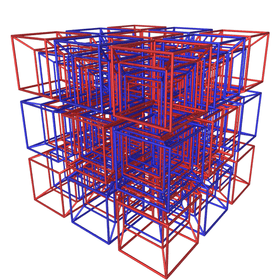Tesseractic honeycomb
| Tesseractic honeycomb | |
|---|---|
 Perspective projection of a 3x3x3x3 red-blue chessboard. | |
| Type | Regular 4-space honeycomb Uniform 4-honeycomb |
| Family | Hypercubic honeycomb |
| Schläfli symbols | {4,3,3,4} t0,4{4,3,3,4} {4,3,31,1} {4,4}2 {4,3,4}x{∞} {4,4}x{∞}2 {∞}4 |
| Coxeter-Dynkin diagrams | |
| 4-face type | {4,3,3} |
| Cell type | {4,3} |
| Face type | {4} |
| Edge figure | {3,4} (octahedron) |
| Vertex figure | {3,3,4} (16-cell) |
| Coxeter groups |
, [4,3,3,4] , [4,3,31,1] |
| Dual | self-dual |
| Properties | vertex-transitive, edge-transitive, face-transitive, cell-transitive, 4-face-transitive |
In four-dimensional euclidean geometry, the tesseractic honeycomb is one of the three regular space-filling tessellations (or honeycombs), represented by Schläfli symbol {4,3,3,4}, and constructed by a 4-dimensional packing of tesseract facets.
Its vertex figure is a 16-cell. Two tesseracts meet at each cubic cell, four meet at each square face, eight meet on each edge, and sixteen meet at each vertex.
It is an analog of the square tiling, {4,4}, of the plane and the cubic honeycomb, {4,3,4}, of 3-space. These are all part of the hypercubic honeycomb family of tessellations of the form {4,3,...,3,4}. Tessellations in this family are Self-dual.
Coordinates
Vertices of this honeycomb can be positioned in 4-space in all integer coordinates (i,j,k,l).
Constructions
There are many different Wythoff constructions of this honeycomb. The most symmetric form is regular, with Schläfli symbol {4,3,3,4}. Another form has two alternating tesseract facets (like a checkerboard) with Schläfli symbol {4,3,31,1}. The lowest symmetry Wythoff construction has 16 types of facets around each vertex and a prismatic product Schläfli symbol {∞}4. One can be made by stericating another.
Related polytopes and tessellations
The [4,3,3,4], ![]()
![]()
![]()
![]()
![]()
![]()
![]()
![]()
![]()
| C4 honeycombs | |||
|---|---|---|---|
| Extended symmetry |
Extended diagram |
Order | Honeycombs |
| [4,3,3,4]: | ×1 | ||
| [[4,3,3,4]] | ×2 | ||
| [(3,3)[1+,4,3,3,4,1+]] ↔ [(3,3)[31,1,1,1]] ↔ [3,4,3,3] |
↔ ↔ |
×6 | |
The [4,3,31,1], ![]()
![]()
![]()
![]()
![]()
![]()
![]()
| B4 honeycombs | ||||
|---|---|---|---|---|
| Extended symmetry |
Extended diagram |
Order | Honeycombs | |
| [4,3,31,1]: | ×1 | |||
| <[4,3,31,1]>: ↔[4,3,3,4] |
↔ |
×2 | ||
| [3[1+,4,3,31,1]] ↔ [3[3,31,1,1]] ↔ [3,3,4,3] |
↔ ↔ |
×3 | ||
| [(3,3)[1+,4,3,31,1]] ↔ [(3,3)[31,1,1,1]] ↔ [3,4,3,3] |
↔ ↔ |
×12 | ||
The 24-cell honeycomb is similar, but as a body centered cubic, it has vertices positioned at integers (i,j,k,l), and half integers (i+1/2,j+1/2,k+1/2,l+1/2).
The tesseract can make a regular tessellation of the 4-sphere, with three tesseracts per face, with Schläfli symbol {4,3,3,3}, called an order-3 tesseractic honeycomb. It is topologically equivalent to the regular polytope penteract in 5-space.
The tesseract can make a regular tessellation of 4-dimensional hyperbolic space, with 5 tesseracts around each face, with Schläfli symbol {4,3,3,5}, called an order-5 tesseractic honeycomb.
Birectified tesseractic honeycomb
A birectified tesseractic honeycomb, ![]()
![]()
![]()
![]()
![]()
See also
Regular and uniform honeycombs in 4-space:
References
- Coxeter, H.S.M. Regular Polytopes, (3rd edition, 1973), Dover edition, ISBN 0-486-61480-8 p. 296, Table II: Regular honeycombs
- Kaleidoscopes: Selected Writings of H.S.M. Coxeter, edited by F. Arthur Sherk, Peter McMullen, Anthony C. Thompson, Asia Ivic Weiss, Wiley-Interscience Publication, 1995,
ISBN 978-0-471-01003-6
- (Paper 24) H.S.M. Coxeter, Regular and Semi-Regular Polytopes III, [Math. Zeit. 200 (1988) 3-45]
- George Olshevsky, Uniform Panoploid Tetracombs, Manuscript (2006) (Complete list of 11 convex uniform tilings, 28 convex uniform honeycombs, and 143 convex uniform tetracombs) - Model 1
- Klitzing, Richard. "4D Euclidean tesselations". x∞o x∞o x∞o x∞o, x∞x x∞o x∞o x∞o, x∞x x∞x x∞o x∞o, x∞x x∞x x∞x x∞o,x∞x x∞x x∞x x∞x, x∞o x∞o x4o4o, x∞o x∞o o4x4o, x∞x x∞o x4o4o, x∞x x∞o o4x4o, x∞o x∞o x4o4x, x∞x x∞x x4o4o, x∞x x∞x o4x4o, x∞x x∞o x4o4x, x∞x x∞x x4o4x, x4o4x x4o4x, x4o4x o4x4o, x4o4x x4o4o, o4x4o o4x4o, x4o4o o4x4o, x4o4o x4o4o, x∞x o3o3o *d4x, x∞o o3o3o *d4x, x∞x x4o3o4x, x∞o x4o3o4x, x∞x x4o3o4o, x∞o x4o3o4o, o3o3o *b3o4x, x4o3o3o4x, x4o3o3o4o - test - O1
Fundamental convex regular and uniform honeycombs in dimensions 2-9 | ||||||
|---|---|---|---|---|---|---|
| Space | Family | / / | ||||
| E2 | Uniform tiling | {3[3]} | δ3 | hδ3 | qδ3 | Hexagonal |
| E3 | Uniform convex honeycomb | {3[4]} | δ4 | hδ4 | qδ4 | |
| E4 | Uniform 4-honeycomb | {3[5]} | δ5 | hδ5 | qδ5 | 24-cell honeycomb |
| E5 | Uniform 5-honeycomb | {3[6]} | δ6 | hδ6 | qδ6 | |
| E6 | Uniform 6-honeycomb | {3[7]} | δ7 | hδ7 | qδ7 | 222 |
| E7 | Uniform 7-honeycomb | {3[8]} | δ8 | hδ8 | qδ8 | 133 • 331 |
| E8 | Uniform 8-honeycomb | {3[9]} | δ9 | hδ9 | qδ9 | 152 • 251 • 521 |
| E9 | Uniform 9-honeycomb | {3[10]} | δ10 | hδ10 | qδ10 | |
| En-1 | Uniform (n-1)-honeycomb | {3[n]} | δn | hδn | qδn | 1k2 • 2k1 • k21 |